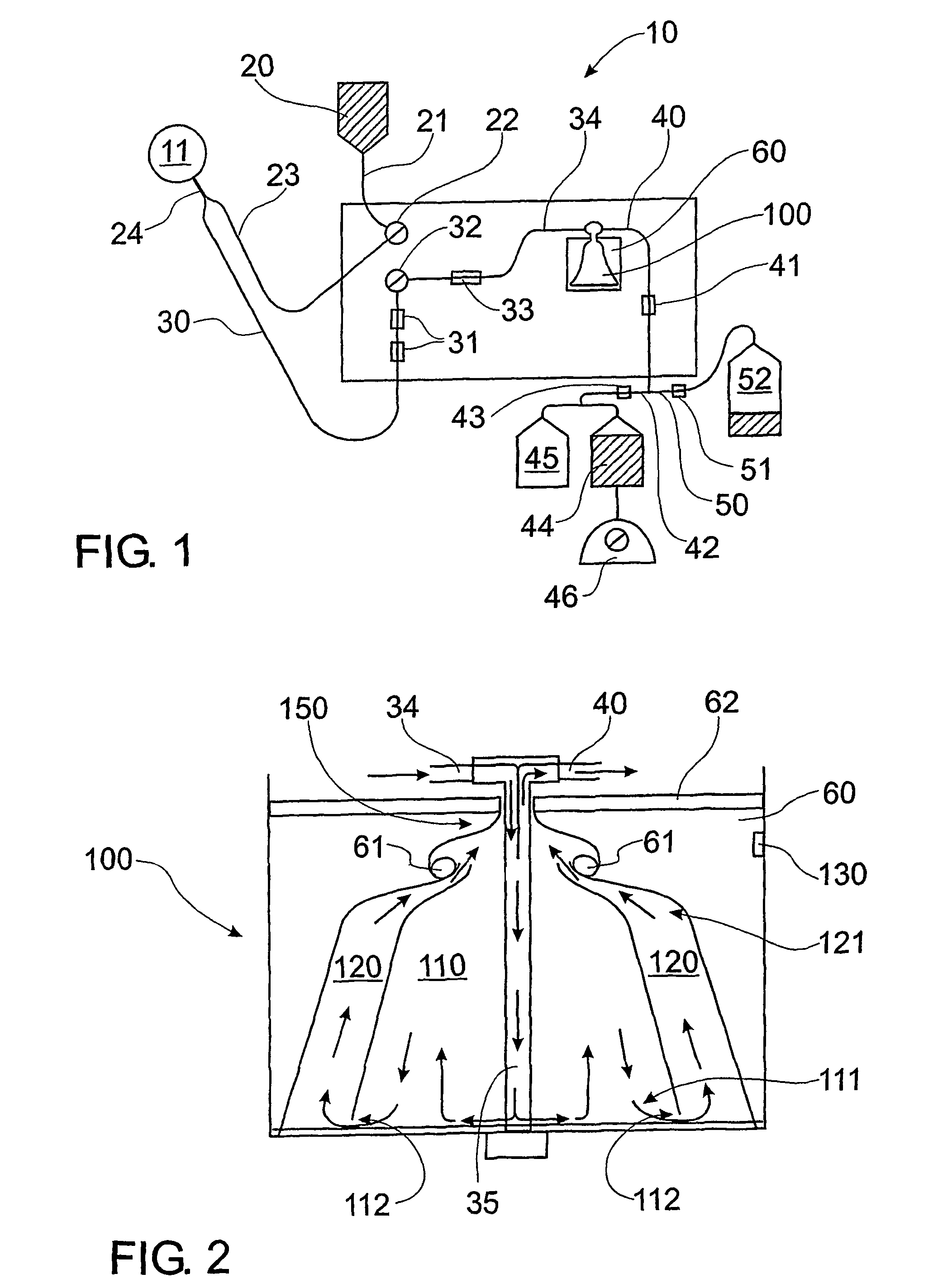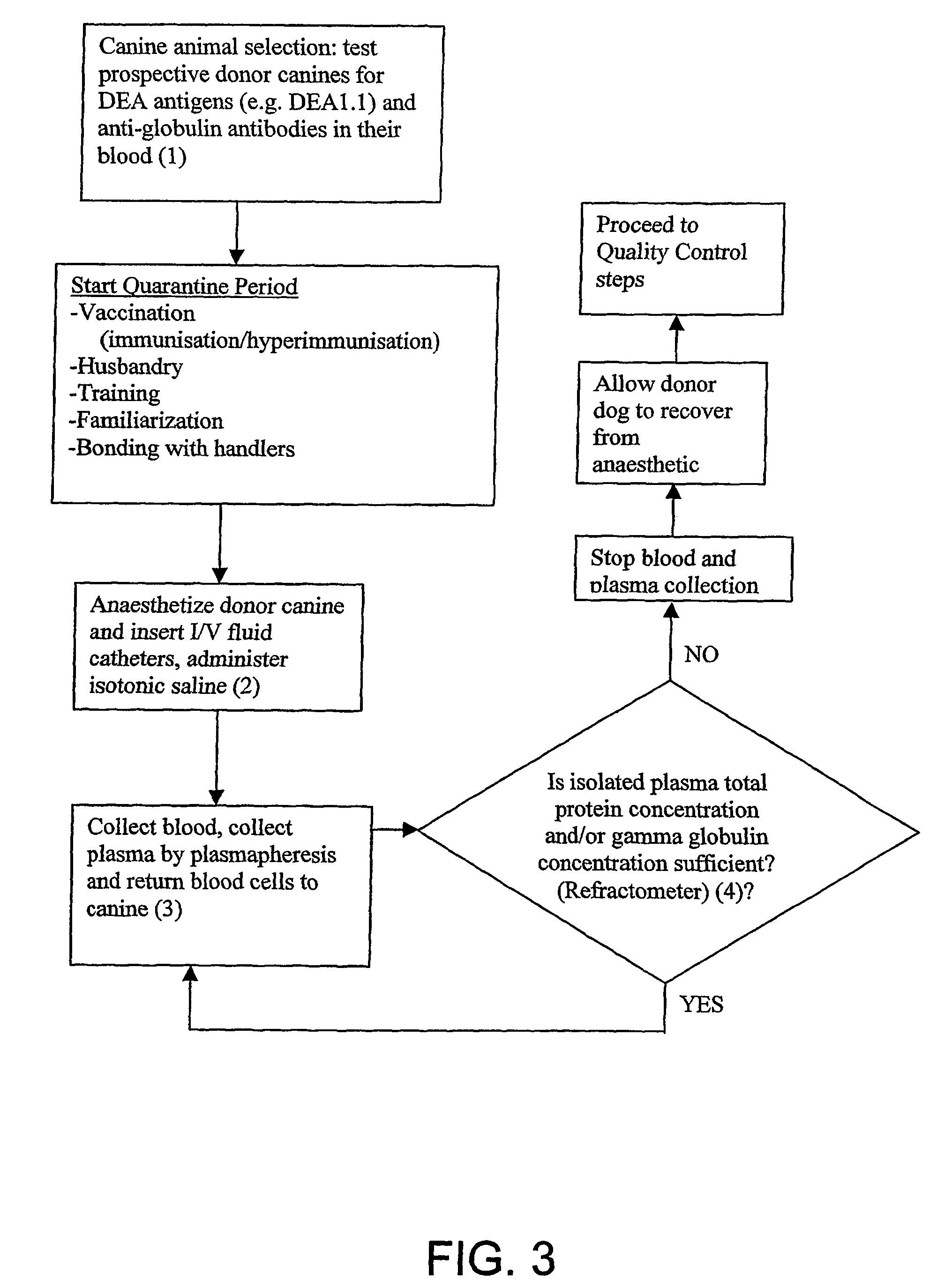Isolated plasma and method for hyperimmunisation and plasma collection
a plasma collection method and plasma collection technology, applied in the field of isolated plasma, canine animals hyperimmunisation and plasma collection, can solve the problems of fatal infections/reactions in recipient patients, patient to considerable potential for adverse treatment, and only moderately satisfactory plasma obtained using the above method
- Summary
- Abstract
- Description
- Claims
- Application Information
AI Technical Summary
Benefits of technology
Problems solved by technology
Method used
Image
Examples
example 1
Testing Prospective Donor Dogs as Suitable for Donating Plasma
Dog Erythrocyte Antigens (DEA)
[0258]A donor dog is preferably characterized by a blood group whose plasma will not cause a plasma transfusion reaction nor trigger haemolysis (e.g. universal plasma donor). Preferably, the canine is negative for at least one Dog Erythrocyte Antigen (DEA). The at least one DEA is preferably selected from the group consisting of: DEA1.1, DEA1.2, DEA3, DEA5, DEA6, DEA7 and DEA8. The canine is preferably at least negative for DEA1.1. More preferably, the canine is farther negative for DEA1.2 and / or DEA7. DEA1.1 may be detected using commercially available kits, including Rapid Vet H card test (Jain N C, Schalm's Veterinary Haematology, 4th Ed. 1986, pp 73-75).
[0259]A suitable canine for use as a plasma donor is the greyhound, which comprises a low frequency of DEA1.1, DEA1.2 and DEA7 blood group antigens.
[0260]Although blood typing of a donor dog is sometime performed in relation to whole blood...
example 2
Hyperimmunization Schedule for Donor Dogs
[0266]Vaccinations for Canine Distemper, Canine Hepatitis, Parvovirus, Kennel Cough due to both Parainfluenza and Bordetella bronchiseptica are commercially available. Vaccines used for hyperimmunisation include: “Canine 4 Vaccine”, (produced by CSL—consisting of living attenuated distemper virus, living attenuated canine adenovirus type 2 (CAV2), living attenuated canine parvovirus type 2 (CPV2) and living attenuated canine parainfluenza virus “Canvac BB Vaccine” (produced by CSL—consisting of an inactivated cell free extract of Bordetella bronchiseptica, in an aluminium salt and 10% thiomersal).
[0267]An anti-endotoxin vaccine (E. coli J5 Vaccine) is preferably prepared according to the method below. However, it will be appreciated that other forms of an anti-endotoxin vaccine may be prepared as is known in the art and / or which may be prepared by a person skilled in the art.
[0268]1. Plate out of E. coli J5 from freeze dried culture onto 5% S...
example 3
General Plasma Collection Protocol
Plasmapheresis or Apheresis
[0279]FIG. 1 is a diagram showing a preferred form of the plasma collection apparatus, comprising a collection kit. The collection kit comprises components made of disposable polypropylene, which improves ease of use and sterility when isolating plasma. The collection kit comprises items 20, 21, 23, 30, 34, 40 and 100 as shown in FIG. 1 and described hereinafter. The collection kit for a plasmaphoresis machine (HAEMONETICS PCS PLUS, Haemonetics Corp) is sterilised using ethylene dioxide gas. The collection kit is fitted to the machine, all tubes and a Centrifuge Bowl or rotor 100 primed (treated) with anticoagulant 4% trisodium citrate. A catheter (blood line 30) inserted into the jugular vein of a donor canine 11 is connected to the HAEMONETICS PCS PLUS via blood line 30 and collection kit and the plasmapheresis process initiated.
[0280]As shown in FIG. 1, bag 20 (500 mL comprising an anticoagulant (4% trisodium citrate) i...
PUM
| Property | Measurement | Unit |
|---|---|---|
| concentration | aaaaa | aaaaa |
| volume | aaaaa | aaaaa |
| volume | aaaaa | aaaaa |
Abstract
Description
Claims
Application Information
 Login to View More
Login to View More - R&D
- Intellectual Property
- Life Sciences
- Materials
- Tech Scout
- Unparalleled Data Quality
- Higher Quality Content
- 60% Fewer Hallucinations
Browse by: Latest US Patents, China's latest patents, Technical Efficacy Thesaurus, Application Domain, Technology Topic, Popular Technical Reports.
© 2025 PatSnap. All rights reserved.Legal|Privacy policy|Modern Slavery Act Transparency Statement|Sitemap|About US| Contact US: help@patsnap.com



